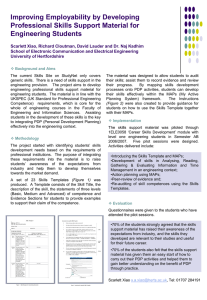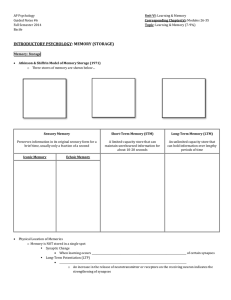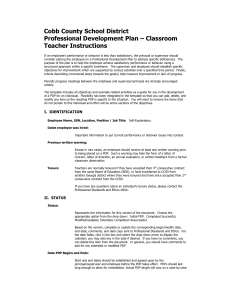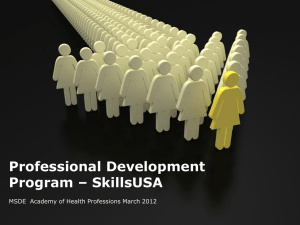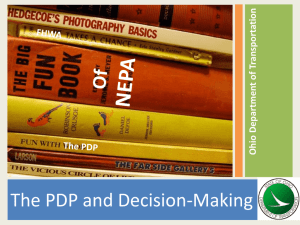What is Cognitive Neuroscience?
advertisement
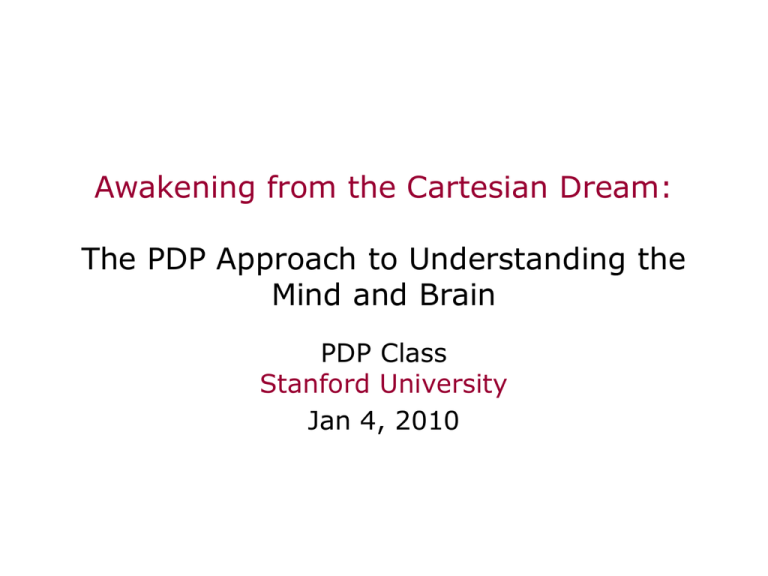
Awakening from the Cartesian Dream: The PDP Approach to Understanding the Mind and Brain PDP Class Stanford University Jan 4, 2010 Decartes’ Legacy • Mechanistic approach to sensation and action • Divine inspiration creates mind • This leads to four dissociations: – Mind / Brain – Higher Cognitive Functions / Sensory-motor systems – Human / Animal – Descriptive / Mechanistic Early History of the Study of Human Mental Processes • Introspectionism (Wundt, Titchener) – Thought as conscious content, but two problems: • Suggestibility • Gaps • Freud suggests that mental processes are not all conscious • Behaviorism (Watson, Skinner) eschews talk of mental processes altogether Early Computational Models of Human Cognition (1950-1980) • • • • • • • • The computer contributes to the overthrow of behaviorism. Computer simulation models emphasize strictly sequential operations, using flow charts. Simon announces that computers can ‘think’. Symbol processing languages are introduced allowing some success at theorem proving, problem solving, etc. Minsky and Pappert kill off Perceptrons. Cognitive psychologists distinguish between algorithm and hardware. Neisser deems physiology to be only of ‘peripheral interest’ Psychologists investigate mental processes as sequences of discrete stages. Ubiquity of the Constraint Satisfaction Problem • In sentence processing – I saw the grand canyon flying to New York – I saw the sheep grazing in the field • In comprehension – Margie was sitting on the front steps when she heard the familiar jingle of the “Good Humor” truck. She remembered her birthday money and ran into the house. • In reaching, grasping, typing… Graded and variable nature of neuronal responses Lateral Inhibition in Eye of Limulus (Horseshoe Crab) The Interactive Activation Model Cognitive Neuropsychology (1970’s) • Geshwind’s disconnection syndromes: – Conduction Aphasia • Patient can understand and produce spoken language but cannot repeat sentences or nonwords – Alexia without Agraphia • Deep and surface dyslexia (1970’s): – Deep dyslexics can’t read non-words (e.g. VINT), make semantic errors in reading words (PEACH -> ‘apricot’) – Surface dyslexics can read non-words, and regular words (e.g. MINT) but often regularize exceptions (PINT). • Work leads to ‘box-and-arrow’ models, reminiscent of flow-charts Graceful Degradation in Neuropsychology • Patient deficits are seldom all or none • And error patterns are far from random: – Visual and semantic errors in deep dyslexia suggest degradation, rather than loss of a module or disconnection – Regularization errors depend on a word’s frequency, and how many other exceptions there are that are like it • Effects of lesions to units and connections in distributed connectionist models nicely capture both of these features of neuropsychological deficits. Features of the PDP Perspective • Processing is in general distributed within and across components of the cognitive system: – Each part contributes to the processing that takes place in other parts. – The outcome of processing anywhere can depend on processing everywhere. • Processing can be very robust for highly typical and frequent items in well-practiced tasks such that considerable degradation can be tolerated before there is an apparent deficit. Core Principles of Parallel Distributed Processing • Processing occurs via interactions among neuronlike processing units via weighted connections. • A representation is a pattern of activation. • The knowledge is in the connections. • Learning occurs through gradual connection adjustment, driven by experience. • Learning affects both representation and processing. /h/ /i/ /n/ H I N T /t/ Implications of this approach • Knowledge that is otherwise represented in explicit form is inherently implicit in PDP: – Rules – Propositions – Lexical entries… • None of these things are represented as such in a PDP system. • Knowledge that others have claimed must be innate and pre-specified domain-by-domain often turns out to be learnable within the PDP approach. • Thus the approach provides a new way of looking at many aspects of knowledge-dependent cognition and development. In short… • Models that link human cognition to the underlying neural mechanisms of the brain simultaneously provide alternatives to earlier ways of understanding processing, learning, and representation at a cognitive level. The PDP Enterprise… • Attempts to explain human cognition as an emergent consequence of neural processes. – Global outcomes, local processes • Forms a natural bridge between cognitive science on the one hand and neuroscience on the other. • Is an ongoing process of exploration. • Depends critically on computational modeling and mathematical analysis. Beyond PDP • Since the PDP work began, several new approaches and comunities have arisen – NIPS/Machine Learning Community – Computational Neuroscience Community – Bayesian Approaches in Cognitive Science and Cognitive Neuroscience • Many of the models we consider belong more to these communities than to what might be called ‘Classic PDP’ • Much of my own work now involves either – Constucting models at the interface between PDP and other approaches – Attempting to understand the relationship between PDP models and models formulated in other frameworks. • A good fraction of the course material will cover work of this type. This course… • Invites you to join the ongoing exploration of PDP and related approaches to mind, brain, and computation. • Focuses ultimately on human cognition and the underlying neural mechanisms. • Includes exercises that provides an introduction to the modeling process and its mathematical foundations, preparing you to join the ongoing exploration.
